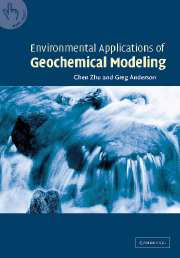Book contents
- Frontmatter
- Contents
- Preface
- 1 Introduction
- 2 Model Concepts
- 3 Thermodynamic Background
- 4 Computer Programs for Geochemical Modeling
- 5 Preparation and Construction of a Geochemical Model
- 6 Speciation and Solubility Modeling
- 7 Modeling Surface Adsorption
- 8 Reaction Path Modeling
- 9 Inverse Mass Balance Modeling
- 10 Coupled Reactive Transport Models
- 11 Kinetics Modeling
- Appendix
- References
- Index
7 - Modeling Surface Adsorption
Published online by Cambridge University Press: 27 March 2010
- Frontmatter
- Contents
- Preface
- 1 Introduction
- 2 Model Concepts
- 3 Thermodynamic Background
- 4 Computer Programs for Geochemical Modeling
- 5 Preparation and Construction of a Geochemical Model
- 6 Speciation and Solubility Modeling
- 7 Modeling Surface Adsorption
- 8 Reaction Path Modeling
- 9 Inverse Mass Balance Modeling
- 10 Coupled Reactive Transport Models
- 11 Kinetics Modeling
- Appendix
- References
- Index
Summary
Introduction
Thermodynamics, as normally defined and as presented in Chapter 3, contains no reference to surfaces. Phases, such as clay minerals and water, are assumed to exist and to equilibrate, based on their bulk properties only. However, in reality, phases interact with each other along interfaces or surfaces, the properties of which are necessarily different from the bulk properties of the phases.
On the surfaces of a phase, the normal environment of each atom is changed, and the atoms are forced to interact with atoms of a different sort, provided by the adjacent phase. In most solids and liquids, bonding is effected by electrical effects-electron transfer, electron sharing, polarization effects, and so on. In the middle of a phase there is a net charge balance, but this is disrupted at surfaces, where the three-dimensional structure is broken. Surfaces are zones where atoms are left with unsatisfied bonds, and therefore surfaces are electrically charged. These charges are accommodated somehow by the adjacent phase, and the case of most interest to geochemical modelers is the case in which one phase is a solid, and the other is water.
The Solid-Water Interface
This interface is quite complex, and is the subject of much active research. We present here the minimum amount of information required to understand what most geochemical modeling programs provide in the way of adsorption modeling at the present time. The capabilities present in widely used modeling programs are of two types – ion-exchange and surface complexation modeling. These represent both the historical development of the subject, and, to some extent, our understanding of two important ways in which ions adsorb to mineral surfaces.
Information
- Type
- Chapter
- Information
- Environmental Applications of Geochemical Modeling , pp. 133 - 156Publisher: Cambridge University PressPrint publication year: 2002
Accessibility standard: Unknown
Why this information is here
This section outlines the accessibility features of this content - including support for screen readers, full keyboard navigation and high-contrast display options. This may not be relevant for you.Accessibility Information
- 2
- Cited by
